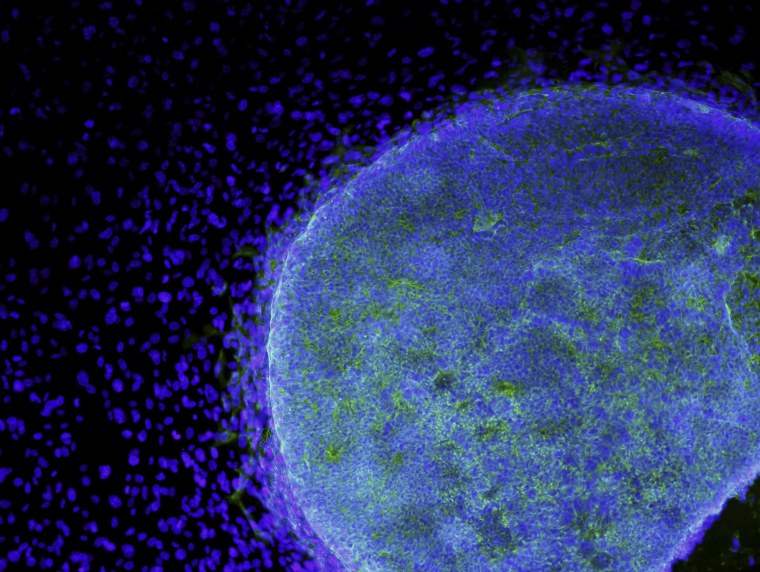What Is the Source of Stem Cells for Medical Research Aborted Babies
Activists who released a video they say shows a Planned Parenthood doctor discussing the auction of tissue from aborted fetuses accept riled upwardly abortion-rights opponents, with House Speaker John Boehner saying the case makes him want to "vomit" and Republican-controlled committees in Congress promising to investigate.
The political firestorm raises a question: Why would anyone apply tissue from an aborted fetus?
It's because some scientists hope they might provide cures for a range of diseases from Parkinson's to crushed spinal cords.
A Source of Stem Cells
Cells from embryos and very early fetuses have properties that fully developed cells practise non. What most researchers are later if they utilize fetal tissue are the stem cells.
The term "stem cell" is confusing because it encompasses many different types of cells. At that place are the embryonic stem cells, which come from days-old embryos and which have the ability to morph into whatever type of cell in the torso – blood, brain, bone or organ. They can exist difficult to direct and there'southward a whole industry devoted to orchestrating the growth and evolution of these cells into desired tissue types.

Then there are adult stem cells, found in everyone's body. These are the stalk cells that are taken from the os marrow, for example, to treat patients with cancer. They're already partially adult and they also can arm-twist an immune response if transplanted into some other person'southward trunk. That'due south why clinics wait then difficult for someone who is a "match" for a bone marrow transplant.
Fetal stem cells fall somewhere in between. They grow well in lab dishes and tin be kept alive and thriving for years. They're not fully adult and then they don't cause the life-threatening immune response that adult stem cells do when transplanted into somebody.

Information technology's not articulate just how frequently these cells are gathered for research uses. Scientists grow batches of cells from many different sources and those that thrive are used for years and passed effectually. The volume "The Immortal Life of Henrietta Lacks" focuses on ane batch that'due south been used for decades, taken from a cervical cancer patient.
From Vaccines to Regenerative Medicine
Fetal cells were used to develop vaccines, including the measles and polio vaccines.
Companies such every bit NeuralStem Inc. take adult cells taken from aborted fetuses into possible therapies. They're testing some now in people with crushed spinal cords who cannot walk, to see if the cells can grow over the injury and restore the nerve connections.
A team at Harvard Medical School's McLean Hospital has been testing fetal stem cells in patients with Parkinson's illness. In Parkinson's, the brain cells that produce an important message-carrying chemic called dopamine are destroyed. The transplants aim to replace those cells and restore the dopamine.
They've had dramatic effects in some patients, not-and then-dramatic furnishings in others.
In that location's work developing stem cells from all iii sources to treat type-1 or juvenile diabetes, which is caused when the body mistakenly destroys the pancreas cells that produce insulin. Cells from fetal liver or pancreas have been tested – either source might be well primed to develop into the desired jail cell type.

Organ Shortages
The case of diabetes especially illustrates why fetal tissue might exist needed: not enough people donate organs after death. There's a procedure chosen the Edmonton Protocol, in which pancreatic cells can be transplanted from the bodies of people who have merely died.
It'south given several hundred patients a interruption from taking insulin, although the transplant eventually fails in almost everyone and they must return to taking insulin. Diabetes researchers complain it'southward very difficult to get the pancreas cells they need, because there is such a shortage of donated organs. Co-ordinate to the United Network for Organ Sharing, more than 123,000 Americans are waiting for an organ transplant.
So what scientists are working on is to create batches of cells, or even whole organs, in the labs. Supporters of stem cell research say all different kinds of stalk cells are needed for this work until the best method for producing these regenerative tissues can be plant.
"Given the enormous potential of stem cells to the development of new therapies for the nearly devastating diseases, information technology is important to simultaneously pursue all lines of promising enquiry," the National Institutes of Wellness says on its website.
Profit or Helping Medicine?
The activists, who vest to a little-known grouping chosen the Middle for Medical Progress, say they made the video to testify that Planned Parenthood sells organs and tissues from abortions. Planned Parenthood denies it.
"I want to be really articulate: The allegation that Planned Parenthood profits in whatsoever way from tissue donation is not true," Planned Parenthood president Cecile Richards says in a statement released Wednesday.
Simply this calendar week a team at the University of California San Francisco published a written report showing that 95 percent of women who had abortions did non regret it. Planned Parenthood said if a adult female has decided to have an abortion, then altruistic the tissue otherwise bound for an incinerator at least helps medical science.
"I give thanks those women and families who have chosen tissue donation at some signal in their lives," Richards said. "Your delivery to lifesaving research, developing treatments for diseases like Parkinson's and Alzheimer's, is of import and compassionate, and it should exist respected – non attacked."
The full two-hr-long video shows the activists, who are posing as staffers from a biotechnology company seeking fetal tissue, wining and dining Dr. Deborah Nucatola, senior managing director of medical services for Planned Parenthood Federation of America. They discuss how to obtain tissue from aborted fetuses.
Nucatola can be heard repeatedly denying the tissue is being sold. "This is non a new revenue stream the affiliates are looking at. This is a way to offering the patient the service that they want, exercise good for the medical customs," she says.
Nonetheless, politicians say the video raises serious questions.
"I could talk nigh the video but I call up I'd vomit trying to talk almost it. Icky," Boehner told reporters Midweek.
Boehner says Congress will investigate. Later a like scandal in 1999, Congress passed a law banning the sale of fetal tissue or body parts, although such tissue may be freely donated.
Legal Battles
Embryonic stem cells were every bit every bit controversial as fetal stem cells for years. Some are fabricated using cloning applied science, while others are fabricated using discarded embryos from fertility clinics. In 2013, after years of legal battles and fights in Congress, the Supreme Court ruled that the federal government could pay for research that uses human embryonic stem cells.
Merely researchers are looking for less controversial and potentially better sources for these cells, anyway. They understand the distaste for using cells from aborted fetuses and even from IVF dispensary leftovers. That's why at that place'due south and then much piece of work to create so-called induced pluripotent stem cells (iPS cells), which would be made using a little piece of a patient's skin, for instance.
These mature cells can be tricked chemically or genetically into reverting to an immature country that resembles fetal or embryonic stem cells, and then directed to develop into liver, or muscle, or nerve, or other desired tissue blazon.
This piece of work with pluripotent stem cells has eclipsed much of the work done using fetal tissue. The NIH spent $166 million funding human embryonic stem cell research in 2014 versus $76 1000000 on enquiry involving man fetal tissue.
What Is the Source of Stem Cells for Medical Research Aborted Babies
Source: https://www.nbcnews.com/health/health-news/planned-parenthood-video-raises-question-why-use-tissue-fetuses-n393431